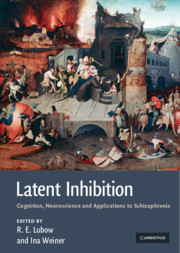Book contents
- Frontmatter
- Contents
- List of contributors
- Preface
- 1 A short history of latent inhibition research
- Current topics in latent inhibition research
- 2 Latent inhibition and extinction: their signature phenomena and the role of prediction error
- 3 Inter-stage context and time as determinants of latent inhibition
- 4 Latent inhibition: acquisition or performance deficit?
- 5 Latent inhibition and learned irrelevance in human contingency learning
- 6 Associative and nonassociative processes in latent inhibition: an elaboration of the Pearce–Hall model
- 7 From latent inhibition to retrospective revaluation: an attentional-associative model
- 8 Latent inhibition and habituation: evaluation of an associative analysis
- 9 Latent inhibition and creativity
- 10 The phylogenetic distribution of latent inhibition
- 11 The genetics of latent inhibition: studies of inbred and mutant mice
- 12 A comparison of mechanisms underlying the CS–US association and the CS–nothing association
- 13 The pharmacology of latent inhibition and its relevance to schizophrenia
- 14 Parahippocampal region–dopaminergic neuron relationships in latent inhibition
- 15 Latent inhibition and other salience modulation effects: same neural substrates?
- 16 What the brain teaches us about latent inhibition (LI): the neural substrates of the expression and prevention of LI
- 17 Latent inhibition in schizophrenia and schizotypy: a review of the empirical literature
- 18 A cautionary note about latent inhibition in schizophrenia: are we ignoring relevant information?
- 19 Latent inhibition as a function of anxiety and stress: implications for schizophrenia
- 20 Nicotinic modulation of attentional deficits in schizophrenia
- 21 Latent inhibition and schizophrenia: the ins and outs of context
- Summary and conclusions
- Index
- References
2 - Latent inhibition and extinction: their signature phenomena and the role of prediction error
from Current topics in latent inhibition research
Published online by Cambridge University Press: 04 August 2010
- Frontmatter
- Contents
- List of contributors
- Preface
- 1 A short history of latent inhibition research
- Current topics in latent inhibition research
- 2 Latent inhibition and extinction: their signature phenomena and the role of prediction error
- 3 Inter-stage context and time as determinants of latent inhibition
- 4 Latent inhibition: acquisition or performance deficit?
- 5 Latent inhibition and learned irrelevance in human contingency learning
- 6 Associative and nonassociative processes in latent inhibition: an elaboration of the Pearce–Hall model
- 7 From latent inhibition to retrospective revaluation: an attentional-associative model
- 8 Latent inhibition and habituation: evaluation of an associative analysis
- 9 Latent inhibition and creativity
- 10 The phylogenetic distribution of latent inhibition
- 11 The genetics of latent inhibition: studies of inbred and mutant mice
- 12 A comparison of mechanisms underlying the CS–US association and the CS–nothing association
- 13 The pharmacology of latent inhibition and its relevance to schizophrenia
- 14 Parahippocampal region–dopaminergic neuron relationships in latent inhibition
- 15 Latent inhibition and other salience modulation effects: same neural substrates?
- 16 What the brain teaches us about latent inhibition (LI): the neural substrates of the expression and prevention of LI
- 17 Latent inhibition in schizophrenia and schizotypy: a review of the empirical literature
- 18 A cautionary note about latent inhibition in schizophrenia: are we ignoring relevant information?
- 19 Latent inhibition as a function of anxiety and stress: implications for schizophrenia
- 20 Nicotinic modulation of attentional deficits in schizophrenia
- 21 Latent inhibition and schizophrenia: the ins and outs of context
- Summary and conclusions
- Index
- References
Summary
Introduction
The simplest way to study learning is to expose subjects to a stimulus and then assess whether they show some effect which is absent in subjects lacking that experience (see Rescorla, 1998). One stimulus exposure effect is latent inhibition. Subjects in one group but not another are exposed to a stimulus in the absence of any other scheduled event. Then subjects in both groups are exposed to a signaling relation between that stimulus (the conditioned stimulus (CS)) and a motivationally significant event (an unconditioned stimulus (US)). The responding elicited by the CS in subjects just exposed to the signaling relation is depressed in those pre-exposed to the stimulus. Conditioned responding is said to have been latently inhibited by the prior stimulus-alone exposures. This effect has also been observed in a within-subject design where subjects are first exposed to one stimulus but not to another and then to a signaling relation between each of these stimuli and a US. Responding develops more rapidly to the novel CS than to one that had been pre-exposed (e.g., Killcross & Robbins, 1993; Rescorla, 2002a, 2002b).
Another effect of stimulus exposures is extinction. Two groups of subjects are exposed to a signaling relation between a CS and US. Then subjects in one group but not the other are exposed to the CS in the absence of any other scheduled event. The responding elicited by the CS in subjects just exposed to the signaling relation is depressed in those that additionally received the CS-alone exposures.
- Type
- Chapter
- Information
- Latent InhibitionCognition, Neuroscience and Applications to Schizophrenia, pp. 23 - 39Publisher: Cambridge University PressPrint publication year: 2010
References
- 11
- Cited by



